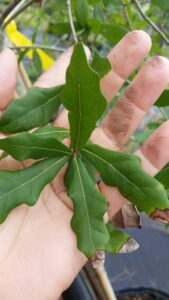S & J Nursery’s Guide to Growing a
Laurel Oak Tree
for the Northeast Florida Landscape
( Quercus laurifolia )
Laurel Oak ( Quercus laurifolia )
Laurel Oak Origins:
– native to the southeastern United States
Laurel Oak Preferred Exposure:
– full sun to light shade
Laurel Oak Foliage | Bark:
– Semi deciduous foliage of the Laurel Oak tree may only drop 20-30 percent of its leaf structure in the winter in the North Florida | Jacksonville | St. Augustine landscape, the Laurel Oak when planted farther north will have yellow fall color and defoliate for the winter.
– Foliage is a bright slightly shiny green color on the surface and
undersides of the leaf, helping to differentiate it from the similar looking Live Oak that will have a slightly darker green thicker leaf with a whitish green underside to the leaf.
– Grayish brown bark is smooth when new and textured with age.
Laurel Oak Soil Preference / Salt tolerance:
– moist, but well drained soils
– not salt tolerant
Laurel Oak Size Variance:
– Can reach sizes of 60+ feet H | 35-45+ feet W depending on
pruning and environmental factors
Laurel Oak Growth Habit:
– upright round oval shaped crown that is taller than it is wide
Laurel Oak Growth Rate:
– Fast
Laurel Oak Bloom:
– inconspicuous blooms followed by acorns
Laurel Oak Water Requirements:
– regular water
Butterfly or Bird Attracting:
– bird and squirrel attracting
Best Uses For Laurel Oaks in the North Florida | Jacksonville | St. Augustine
area landscape:
– Laurel Oaks are a good choice for a fast growing Oak or low maintenance
larger scale shade tree in any soil condition found in the North Florida | Jacksonville | St. Augustine area landscape including soils that are occasionally wet.
– Semi evergreen habit and a rounded oval shape make this an attractive landscape tree year round.
– Take care to choose an appropriate spot in the landscape away from sidewalks, driveways and other hardscape surfaces so as not to be disturbed by mature tree roots.
Care of Laurel Oaks:
– water every day during the establishment period. See watering your newly planted trees for more information.
– provide a 1 ft diameter circle of mulched area where grass is kept from growing for each inch of caliper (or diameter) of trunk measured 4 inches from the ground level.
– fertilize each spring with a mixture of milorganite and a slow release poly
coated plant food such as Osmocote or Stay Green general purpose plant food, sprinkling the fertilizer around the mulch circle underneath the foliage of the tree

